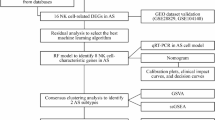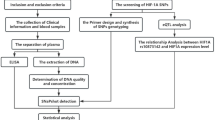Abstract
Coronary atherosclerosis is a complex and progressive condition that involves many biological pathways, including the oxidative stress and inflammatory response pathways. To investigate the association between common genetic variation within these two pathways and coronary atherosclerosis, we performed a comprehensive two-stage candidate gene association study in a Chinese Han population. In stage I, 936 tag single-nucleotide polymorphisms (SNPs) within 116 candidate genes were genotyped in 293 coronary atherosclerosis cases and 293 age- and gender-matched healthy controls. In stage II, 51 SNPs from stage I were selected and further genotyped in an additional 1030 cases and 764 controls. In allele- and genotype-based association tests of stage II and a meta-analysis across the two stages, we identified three SNPs within three genes significantly associated with the disease, namely rs3212556 in ITGA2 (PCMH=9.20 × 10−5), rs854563 in PON1 (PCMH=1.92 × 10−4) and rs9283851 in THBS2 (PCMH=3.00 × 10−3). Haplotype analysis provided further supporting evidence for the association of rs3212556 (Pglobal<10−4) and rs854563 (Pglobal<10−4). Our study has identified three SNPs within ITGA2, PON1 and THBS2 that are associated with coronary atherosclerosis.
Similar content being viewed by others
Log in or create a free account to read this content
Gain free access to this article, as well as selected content from this journal and more on nature.com
or
References
WHO publishes definitive atlas on global heart disease and stroke epidemic. Indian J. Med. Sci 58, 405–406 (2004).
Reddy, K. S. Cardiovascular disease in non-Western countries. N. Engl. J. Med. 350, 2438–2440 (2004).
Mates, J. M., Perez-Gomez, C. & Nunez de Castro, I. Antioxidant enzymes and human diseases. Clin. Biochem. 32, 595–603 (1999).
Ross, R. Atherosclerosis–an inflammatory disease. N. Engl. J. Med. 340, 115–126 (1999).
Dzau, V. J., Braun-Dullaeus, R. C. & Sedding, D. G. Vascular proliferation and atherosclerosis: new perspectives and therapeutic strategies. Nat. Med. 8, 1249–1256 (2002).
Hansson, G. K. Inflammation, atherosclerosis, and coronary artery disease. N. Engl. J. Med. 352, 1685–1695 (2005).
Libby, P. Inflammation in atherosclerosis. Nature 420, 868–874 (2002).
Lusis, A. J. Atherosclerosis. Nature 407, 233–241 (2000).
Wellcome Trust Case Control Consortium. Genome-wide association study of 14 000 cases of seven common diseases and 3000 shared controls. Nature 447, 661–678 (2007).
Arroyo-Espliguero, R., Avanzas, P., Jeffery, S. & Kaski, J. C. CD14 and toll-like receptor 4: a link between infection and acute coronary events? Heart 90, 983–988 (2004).
Edfeldt, K., Bennet, A. M., Eriksson, P., Frostegard, J., Wiman, B., Hamsten, A. et al. Association of hypo-responsive toll-like receptor 4 variants with risk of myocardial infarction. Eur. Heart J. 25, 1447–1453 (2004).
McDermott, D. H., Yang, Q., Kathiresan, S., Cupples, L. A., Massaro, J. M., Keaney, J. F. Jr et al. CCL2 polymorphisms are associated with serum monocyte chemoattractant protein-1 levels and myocardial infarction in the Framingham. Heart Study Circ. 112, 1113–1120 (2005).
Zhang, X., Han, Y., Kang, J. & Yan, C. A monocyte chemoattractant protein-1 gene polymorphism is not associated with coronary artery disease in a Han Chinese population. Clin. Chim. Acta. 403, 241–243 (2009).
Carlson, C. S., Eberle, M. A., Rieder, M. J., Yi, Q., Kruglyak, L. & Nickerson, D. A. Selecting a maximally informative set of single-nucleotide polymorphisms for association analyses using linkage disequilibrium. Am. J. Hum. Genet. 74, 106–120 (2004).
Hudson, R. R. Genetic Data Analysis. Methods for Discrete Population Genetic Data, Bruce S. Weir. Sinauer, Sunderland, MA, 1990. xiv, 377 pp., illus. $48; paper, $27. Science. 250, 575 (1990).
Barrett, J. C., Fry, B., Maller, J. & Daly, M. J. Haploview: analysis and visualization of LD and haplotype maps. Bioinformatics 21, 263–265 (2005).
Schaid, D. J., Rowland, C. M., Tines, D. E., Jacobson, R. M. & Poland, G. A. Score tests for association between traits and haplotypes when linkage phase is ambiguous. Am. J. Hum. Genet. 70, 425–434 (2002).
Chen, J., Zheng, H., Bei, J. X., Sun, L., Jia, W. H., Li, T. et al. Genetic structure of the Han Chinese population revealed by genome-wide SNP variation. Am. J. Hum. Genet. 85, 775–785 (2009).
Kritzik, M., Savage, B., Nugent, D. J., Santoso, S., Ruggeri, Z. M. & Kunicki, T. J. Nucleotide polymorphisms in the alpha 2 gene define multiple alleles that are associated with differences in platelet alpha 2beta 1 density. Blood 92, 2382–2388 (1998).
Ajzenberg, N., Berroeta, C., Philip, I., Grandchamp, B., Ducellier, P., Huart, V. et al. Association of the -92C/G and 807C/T polymorphisms of the {alpha}2 subunit gene with human platelets {alpha}2{beta}1 receptor density. Arterioscler. Thromb. Vasc. Biol. 25, 1756–1760 (2005).
Kostidou, E., Koliakos, G., Paletas, K. & Kaloyianni, M. Monocyte attachment and migration through collagen IV in diabetes mellitus. Mol. Cells 25, 452–456 (2008).
Serrato, M. & Marian, A. J. A variant of human paraoxonase/arylesterase (HUMPONA) gene is a risk factor for coronary artery disease. J. Clin. Invest. 96, 3005–3008 (1995).
Christiansen, L., Bathum, L., Frederiksen, H. & Christensen, K. Paraoxonase 1 polymorphisms and survival. Eur. J. Hum. Genet. 12, 843–847 (2004).
Mackness, B., Davies, G. K., Turkie, W., Lee, E., Roberts, D. H., Hill, E. et al. Paraoxonase status in coronary heart disease: are activity and concentration more important than genotype? Arterioscler. Thromb. Vasc. Biol. 21, 1451–1457 (2001).
Mackness, B., Durrington, P., McElduff, P., Yarnell, J., Azam, N., Watt, M. et al. Low paraoxonase activity predicts coronary events in the Caerphilly Prospective Study. Circulation 107, 2775–2779 (2003).
McCarthy, J. J., Parker, A., Salem, R., Moliterno, D. J., Wang, Q., Plow, E. F. et al. Large scale association analysis for identification of genes underlying premature coronary heart disease: cumulative perspective from analysis of 111 candidate genes. J. Med. Genet. 41, 334–341 (2004).
Boekholdt, S. M., Trip, M. D., Peters, R. J. G., Engelen, M., Boer, J. M. A., Feskens, E. J. M. et al. Thrombospondin-2 polymorphism is associated with a reduced risk of premature myocardial infarction. Arterioscler. Thromb. Vasc. Biol. 22, e24–27 (2002).
Bornstein, P. Diversity of function is inherent in matricellular proteins: an appraisal of thrombospondin 1. J. Cell. Biol. 130, 503–506 (1995).
Yang, Z., Kyriakides, T. R. & Bornstein, P. Matricellular proteins as modulators of cell-matrix interactions: adhesive defect in thrombospondin 2-null fibroblasts is a consequence of increased levels of matrix metalloproteinase-2. Mol. Biol. Cell. 11, 3353–3364 (2000).
Noji, Y., Kajinami, K., Kawashiri, M. A., Todo, Y., Horita, T., Nohara, A. et al. Circulating matrix metalloproteinases and their inhibitors in premature coronary atherosclerosis. Clin. Chem. Lab. Med. 39, 380–384 (2001).
Kyriakides, T. R., Zhu, Y.- H., Smith, L. T., Bain, S. D., Yang, Z., Lin, M. T. et al. Mice that lack thrombospondin 2 display connective tissue abnormalities that are associated with disordered collagen fibrillogenesis, an increased vascular density, and a bleeding diathesis. J. Cell Biol. 140, 419–430 (1998).
Acknowledgements
We are most grateful to all the individuals who participated in this study and the collaborating clinics and physicians for referring individuals to the study. We thank Professor Momiao Xiong of Human Genetics Center, The University of Texas Health Science Center (Houston, TX, USA) for his encouraging discussion, Professor Aijun Sun of the Department of Cardiology, Zhongshan Hospital, Fudan University for their cooperation in collecting blood samples. The work was supported by the grants from Chinese High-Tech Program (2006AA020706, 2006AA02A406), Chinese National Natural Science Fund for Distinguished Young Scholars (30625019) and Shanghai Science and Technology Committee (09DZ2291900).
Author information
Authors and Affiliations
Corresponding author
Additional information
Supplementary Information accompanies the paper on Journal of Human Genetics website
Supplementary information
Rights and permissions
About this article
Cite this article
Wang, Y., Fu, W., Xie, F. et al. Common polymorphisms in ITGA2, PON1 and THBS2 are associated with coronary atherosclerosis in a candidate gene association study of the Chinese Han population. J Hum Genet 55, 490–494 (2010). https://doi.org/10.1038/jhg.2010.53
Received:
Revised:
Accepted:
Published:
Issue date:
DOI: https://doi.org/10.1038/jhg.2010.53
Keywords
This article is cited by
-
An Myh11 single lysine deletion causes aortic dissection by reducing aortic structural integrity and contractility
Scientific Reports (2022)
-
Investigation of candidate genes and mechanisms underlying obesity associated type 2 diabetes mellitus using bioinformatics analysis and screening of small drug molecules
BMC Endocrine Disorders (2021)
-
Association of circulating angiogenesis inhibitors and asymmetric dimethyl arginine with coronary plaque burden
Fibrogenesis & Tissue Repair (2015)
-
MiR-1246 promotes SiHa cervical cancer cell proliferation, invasion, and migration through suppression of its target gene thrombospondin 2
Archives of Gynecology and Obstetrics (2014)
-
Association of PON1 genotype and haplotype with susceptibility to coronary artery disease and clinical outcomes in dual antiplatelet-treated Han Chinese patients
European Journal of Clinical Pharmacology (2013)



